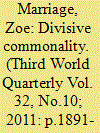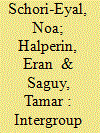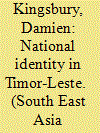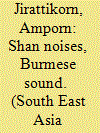|
|
|
Sort Order |
|
|
|
Items / Page
|
|
|
|
|
|
|
| Srl | Item |
| 1 |
ID:
108120


|
|
|
|
|
| Publication |
2011.
|
| Summary/Abstract |
Northern donor policies relating to building a common future and building peaceful states and societies go to the heart of national and international security agendas. This article critiques the concept of commonality between donors and recipients and within recipient countries. It argues that the policies are problematic from the perspective of security theorising, both in their mooted 'commonality' and in terms of the political intervention that they imply. Historically security has been competitive and founded on compromise rather than commonality, and the internal legitimacy of states has been contested domestically, rather than 'built' from outside. Using the example of the Democratic Republic of Congo, the article argues that the ahistorical assumptions of these policies and the activities they license have entrenched specific forms of insecurity. There have been some returns to the donors and implementing partners but also some costs, which had not been calculated, as lessons have not been drawn from past experiences.
|
|
|
|
|
|
|
|
|
|
|
|
|
|
|
|
| 2 |
ID:
166003


|
|
|
|
|
| Summary/Abstract |
Despite their pernicious effect on intergroup conflict, collateral casualties are seen as inevitable and justified by many members of the groups involved, particularly those who endorse a right-wing ideology. Drawing on social psychological literature, we examined whether a perception of commonality between in-group and out-group can be beneficial for reducing tolerance to collateral causalities. We hypothesized that viewing the out-group as sharing commonalities with the in-group can reduce processes of out-group delegitimization, which are common among right-wingers in intractable conflicts, and may therefore serve to explain reduction in tolerance to collateral casualties. Three correlational studies were conducted among Jewish-Israelis in the context of the conflict with the Palestinians to test this. In Study 1, right-wing political ideology was associated with stronger support for enemy collateral casualties, and the effect was moderated by perceived intergroup commonality. While leftists were overall non-supportive of collateral casualties, rightists who perceived high intergroup commonality were less tolerant of collateral casualties than those low on intergroup commonality. In Study 2, conducted during violent escalation, we replicated these results while controlling for anger, fear, and hatred. In Study 3, we found that the effect was mediated by delegitimization of the out-group. These results extend the range of beneficial impact of intergroup commonality, and imply that it may be used as a tool to promote conflict resolution.
|
|
|
|
|
|
|
|
|
|
|
|
|
|
|
|
| 3 |
ID:
095142


|
|
|
|
|
| Publication |
2010.
|
| Summary/Abstract |
Following a long independence struggle and international intervention, in 2006 the tiny impoverished state of Timor-Leste almost imploded in civil chaos and institutional collapse. The events of the time were quickly defined in terms of an east-west geographical and, broadly, linguistic and political divide, corresponding to pro- and anti-government groupings. International intervention quelled the worst of the violence, although elections in 2007 confirmed the general tendency, if not an absolute alignment, to the divide that had appeared in 2006. However, much also united Timor-Leste historically and culturally and, increasingly, in a broad acceptance of civic institutions. It was from this base that the small and sometimes fragile state began to build what promised to be a more coherent future.
|
|
|
|
|
|
|
|
|
|
|
|
|
|
|
|
| 4 |
ID:
095144


|
|
|
|
|
| Publication |
2010.
|
| Summary/Abstract |
This paper examines how ethnic Shan singers use the Burmese language to redefine their own ethnic identity, in the process helping to construct Shans' place in the Burmese national imaginary. The paper focuses on the songs of two Shan artists, Sai Htee Saing and Sai Sai Mao. These two singers have been singing in Burmese for three decades. Both have gained nationwide popularity and are now among the most famous singers in Burma's music industry. The paper consists of two parts. The first one discusses the dynamics of self-representation, examining how Shan artists select and adapt dominant discourses about them to their own task of crafting themselves. The second part investigates the audience reception of these two singers, exploring how particular groups of audience members bring their own ethnicity into interpreting a media text. Through participant observation, interviews with audiences and with the singers themselves, the author seeks to illuminate how such self-fashioning and listening practices reveal complex relations between ethnicity and the popular construction of identity.
|
|
|
|
|
|
|
|
|
|
|
|
|
|
|
|
|
|
|
|
|